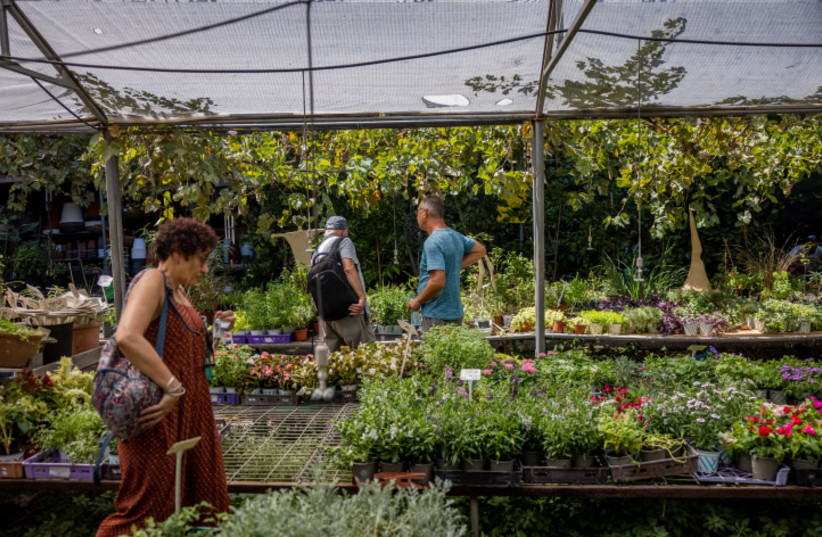It’s springtime now. I’m out in a quiet forest in the Jerusalem foothills, with a group of 20 women. Our mission for the day is to identify and gather wild edibles, between red anemone blossoms and tall trees. One would think that lunch might be hard to come by on a typical Israeli forest floor. But nothing could be further from the truth. This place is a veritable Garden of Eatin’ – there are edible plants, flowers, and roots everywhere.
Under the tutelage of our expert guide Naomi, we pick sharp mustard greens topped with yellow blossoms and gingerly nibble at the leaves. “Maror,” one woman says. “These remind me of the bitter herbs we eat at Passover time.”
I wonder aloud if these delicious mustard greens were the maror of choice at Seders past. That these greens grow wild in Israel at Passover time is a good reason that they would serve as a complement to roasted lamb on Seder night. This seems more likely when considering the romaine lettuce and horseradish root (not native to Israel) now used in most Passover Seders. Naomi points out that mustard greens are considered a delicacy in many places; they make an appearance in fancy organic markets around the world.
After our appetizer, we move on to the less-friendly stinging nettle plant. Called sirpad in Hebrew, these wild greens are mentioned in the book of Isaiah, in descriptions of the redemption when myrtle (hadas) will grow in places of the more rambunctious nettle.
Although this country is now filled with orderly myrtle plants, stinging nettle does still grow wild in Israel’s parks and natural spaces. It’s covered with stingers, but nettle is delicious and nutritious (when handled carefully) and is a great source of iron and other minerals. Handling the leaves from the bottom, we rub the tops together, then taste.
We also gather bags full of khubeiza, the common green malva plant that sustained residents of Jerusalem in 1948, during the siege on our Holy City.

We’ll cook these like spinach, as they did, a little bit later.
Something about the foragers’ feast we find in this forest connects me to our nation’s past. Perhaps it’s partly because we see some of the seven species, wild wheat and barley. Barley’s Hebrew name, seorah, I now understand to refer to the fact that it is covered with small hairs, se-ar.
As our guide tells us, we are not allowed to taste the new wheat growing here in the field, according to religious law, until after Passover. This is one mitzva that most Jews rarely have a chance to observe. But here we are in this grain field, refraining from tasting the green wheat.
Understanding Jewish history through the nature around us
As we gather wild garlic and roots from between just ripening wild legumes, I contemplate the lentil stew we will prepare at the end of the day. Legumes like lentils are an integral part of Jewish history.
Back in biblical times, Esau sold his birthright to Jacob for a pot of red lentil stew, something I learned as a child. Encountering legumes growing wild in Israel, I now understand how our forefathers came by their chosen cuisine.
Then I reach back to my own childhood experience, growing up as a city girl in New Orleans. Were there wild edibles growing in my hometown? I remember the poisonous mushrooms that dotted our lawn, occasional Japanese plum trees growing near the street and honeysuckle. Other than that, my mind is notably blank. Here in Israel, it seems somehow more important to connect to our land in this way.
Once our group of women is done learning and gathering, we spread out blankets on the ground and set about the task of preparing – peeling, chopping, stuffing, cooking. With some hard work, we create a sumptuous feast: of poached wild artichokes, wild herb pesto, stuffed cyclamen leaves, wild green shakshuka with home-farmed eggs, and sweet chamomile tea with our guide’s home-farmed honey.
We’ve brought along our homemade sourdough bread, goat cheese, and pickled vegetables to supplement the menu, and tossed some peppers and eggplants to roast over the open fire. Every item on our picnic blanket was prepared with our very own hands.
The women arrange themselves in a circle around the feast and fill their plates. Gorging ourselves on the fruits of our labor, we all share some thoughts about the day. What meaning did we find in this experience?
One woman says, “Mother.” She pauses. “I keep thinking about the idea of mother: Mother Earth, the imahot [foremothers] like Sara, Rivka, [Leah,] and Rachel. They would have gathered and prepared these very foods right here, together in a group, just like we’re doing today. And I hope we can teach our own children about these foods and pass the tradition along.”
One short morning of outdoor gathering can change the way you look at Israel’s natural world. Seeing nature through this lens has changed my perspective on what sustenance meant in biblical times, when locally grown and gathered foods nourished our spiritual tradition.
